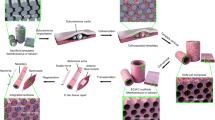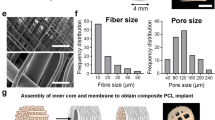Abstract
Biomaterial scaffolds that serve as vehicles for gene delivery to promote expression of inductive factors have numerous regenerative medicine applications. In this report, we investigate plasmid delivery from biomaterial scaffolds using a surface immobilization strategy. Porous scaffolds were fabricated from poly(D,L-lactide-co-glycolide) (PLG), and plasmids were immobilized by drying. In vitro plasmid release indicated that the majority (>70%) of adsorbed plasmids were released within 24 h and >98% within 3 days; however, in vivo implantation of the scaffolds at the subcutaneous site yielded transgene expression that persisted for at least 28 weeks and was localized to the site of implantation. Histological analysis of DNA-adsorbed scaffolds indicated that macrophages at the scaffold were transfected in the first 2 weeks after implantation, whereas muscle cells adjacent to the implant primarily expressed the transgene at 4 weeks. In addition to localized gene expression, a secreted protein (human factor IX) was retained at the implant site and not available systemically after 3 days, indicating minimal off-target effects. These findings show that surface immobilization of plasmid onto microporous PLG scaffolds can produce localized and long-term gene expression in vivo, which may be used to enhance the bioactivity of scaffolds used for regenerative medicine.
This is a preview of subscription content, access via your institution
Access options
Subscribe to this journal
Receive 12 print issues and online access
$259.00 per year
only $21.58 per issue
Buy this article
- Purchase on Springer Link
- Instant access to full article PDF
Prices may be subject to local taxes which are calculated during checkout






Similar content being viewed by others
References
Chandler LA, Gu DL, Ma C, Gonzalez AM, Doukas J, Nguyen T et al. Matrix-enabled gene transfer for cutaneous wound repair. Wound Repair Regen 2000; 8: 473–479.
Endo M, Kuroda S, Kondo H, Maruoka Y, Ohya K, Kasugai S . Bone regeneration by modified gene-activated matrix: effectiveness in segmental tibial defects in rats. Tissue Eng 2006; 12: 489–497.
Guo T, Zhao J, Chang J, Ding Z, Hong H, Chen J et al. Porous chitosan-gelatin scaffold containing plasmid DNA encoding transforming growth factor-beta1 for chondrocytes proliferation. Biomaterials 2006; 27: 1095–1103.
Pan H, Jiang H, Chen W . Interaction of dermal fibroblasts with electrospun composite polymer scaffolds prepared from dextran and poly lactide-co-glycolide. Biomaterials 2006; 27: 3209–3220.
Kong HJ, Kim ES, Huang YC, Mooney DJ . Design of biodegradable hydrogel for the local and sustained delivery of angiogenic plasmid DNA. Pharm Res 2008; 25: 1230–1238.
Wieland JA, Houchin-Ray TL, Shea LD . Non-viral vector delivery from PEG-hyaluronic acid hydrogels. J Control Release 2007; 120: 233–241.
Meilander-Lin NJ, Cheung PJ, Wilson DL, Bellamkonda RV . Sustained in vivo gene delivery from agarose hydrogel prolongs nonviral gene expression in skin. Tissue Eng 2005; 11: 546–555.
Blum JS, Saltzman WM . High loading efficiency and tunable release of plasmid DNA encapsulated in submicron particles fabricated from PLGA conjugated with poly-L-lysine. J Control Release 2008; 129: 66–72.
Bowman K, Sarkar R, Raut S, Leong KW . Gene transfer to hemophilia A mice via oral delivery of FVIII-chitosan nanoparticles. J Control Release 2008; 132: 252–259.
Stern M, Ulrich K, Geddes DM, Alton EW . Poly (D, L-lactide-co-glycolide)/DNA microspheres to facilitate prolonged transgene expression in airway epithelium in vitro, ex vivo and in vivo. Gene Therapy 2003; 10: 1282–1288.
Jang JH, Rives CB, Shea LD . Plasmid delivery in vivo from porous tissue-engineering scaffolds: transgene expression and cellular transfection. Mol Ther 2005; 12: 475–483.
Jang JH, Shea LD . Controllable delivery of non-viral DNA from porous scaffolds. J Control Release 2003; 86: 157–168.
Salvay DM, Rives CB, Zhang X, Chen F, Kaufman DB, Lowe Jr WL et al. Extracellular matrix protein-coated scaffolds promote the reversal of diabetes after extrahepatic islet transplantation. Transplantation 2008; 85: 1456–1464.
De Laporte L, Yang Y, Zelivyanskaya ML, Cummings BJ, Anderson AJ, Shea LD . Plasmid releasing multiple channel bridges for transgene expression after spinal cord injury. Mol Ther 2009; 17: 318–326.
Huang G, Yamaza T, Shea LD, Djouad F, Kuhn NZ, Tuan R et al. Stem/progenitor cell-mediated de novo regeneration of dental pulp with newly deposited continuous layer of dentin in an in vivo model. Tissue Eng Part A 2009; 16: 605–615.
Ali OA, Huebsch N, Cao L, Dranoff G, Mooney DJ . Infection-mimicking materials to program dendritic cells in situ. Nat Mater 2009; 8: 151–158.
El-Ayoubi R, Eliopoulos N, Diraddo R, Galipeau J, Yousefi AM . Design and fabrication of 3D porous scaffolds to facilitate cell-based gene therapy. Tissue Eng Part A 2008; 14: 1037–1048.
Sun XD, Jeng L, Bolliet C, Olsen BR, Spector M . Non-viral endostatin plasmid transfection of mesenchymal stem cells via collagen scaffolds. Biomaterials 2009; 30: 1222–1231.
Jang JH, Rives CB, Shea LD . Plasmid delivery in vivo from porous tissue-engineering scaffolds: transgene expression and cellular transfection. Mol Ther 2005; 12: 475–483.
Murphy WL, Mooney DJ . Controlled delivery of inductive proteins, plasmid DNA and cells from tissue engineering matrices. J Periodontal Res 1999; 34: 413–419.
Jang JH, Bengali Z, Houchin TL, Shea LD . Surface adsorption of DNA to tissue engineering scaffolds for efficient gene delivery. J Biomed Mater Res A 2006; 77: 50–58.
Rives CB, Rieux AD, Zelivyanskaya M, Stock SR, Lowe Jr WL, Shea LD . Layered PLG scaffolds for in vivo plasmid delivery. Biomaterials 2008.
Jang JH, Shea LD . Intramuscular delivery of DNA releasing microspheres: microsphere properties and transgene expression. J Control Release 2006; 112: 120–128.
Nof M, Shea LD . Drug-releasing scaffolds fabricated from drug-loaded microspheres. J Biomed Mater Res 2002; 59: 349–356.
Whittlesey KJ, Shea LD . Delivery systems for small molecule drugs, proteins, and DNA: the neuroscience/biomaterial interface. Exp Neurol 2004; 190: 1–16.
Nathwani AC, Davidoff AM, Hanawa H, Hu Y, Hoffer FA, Nikanorov A et al. Sustained high-level expression of human factor IX (hFIX) after liver-targeted delivery of recombinant adeno-associated virus encoding the hFIX gene in rhesus macaques. Blood 2002; 100: 1662–1669.
Takagi T, Hashiguchi M, Mahato RI, Tokuda H, Takakura Y, Hashida M . Involvement of specific mechanism in plasmid DNA uptake by mouse peritoneal macrophages. Biochem Biophys Res Commun 1998; 245: 729–733.
Takakura Y, Takagi T, Hashiguchi M, Nishikawa M, Yamashita F, Doi T et al. Characterization of plasmid DNA binding and uptake by peritoneal macrophages from class A scavenger receptor knockout mice. Pharm Res 1999; 16: 503–508.
Hyde SC, Pringle IA, Abdullah S, Lawton AE, Davies LA, Varathalingam A et al. CpG-free plasmids confer reduced inflammation and sustained pulmonary gene expression. Nat Biotechnol 2008; 26: 549–551.
Dale DC, Boxer L, Liles WC . The phagocytes: neutrophils and monocytes. Blood 2008; 112: 935–945.
Meuli M, Liu Y, Liggitt D, Kashani-Sabet M, Knauer S, Meuli-Simmen C et al. Efficient gene expression in skin wound sites following local plasmid injection. J Invest Dermatol 2001; 116: 131–135.
Sarkar N, Blomberg P, Wardell E, Eskandarpour M, Sylven C, Drvota V et al. Nonsurgical direct delivery of plasmid DNA into rat heart: time course, dose response, and the influence of different promoters on gene expression. J Cardiovasc Pharmacol 2002; 39: 215–224.
Wolff JA, Ludtke JJ, Acsadi G, Williams P, Jani A . Long-term persistence of plasmid DNA and foreign gene expression in mouse muscle. Hum Mol Genet 1992; 1: 363–369.
Wolff JA, Malone RW, Williams P, Chong W, Acsadi G, Jani A et al. Direct gene transfer into mouse muscle in vivo. Science 1990; 247: 1465–1468.
van Deutekom JC, Hoffman EP, Huard J . Muscle maturation: implications for gene therapy. Mol Med Today 1998; 4: 214–220.
Scherer F, Schillinger U, Putz U, Stemberger A, Plank C . Nonviral vector loaded collagen sponges for sustained gene delivery in vitro and in vivo. J Gene Med 2002; 4: 634–643.
De Laporte L, Shea LD . Matrices and scaffolds for DNA delivery in tissue engineering. Adv Drug Deliv Rev 2007; 59: 292–307.
Olivares EC, Hollis RP, Chalberg TW, Meuse L, Kay MA, Calos MP . Site-specific genomic integration produces therapeutic Factor IX levels in mice. Nat Biotechnol 2002; 20: 1124–1128.
Acknowledgements
We thank Prof. Michele Calos for helpful discussions and the human Factor IX construct. Financial support for this research was provided by NIH RO1EB003806 and RO1EB005678.
Author information
Authors and Affiliations
Corresponding author
Ethics declarations
Competing interests
The authors declare no conflict of interest.
Rights and permissions
About this article
Cite this article
Salvay, D., Zelivyanskaya, M. & Shea, L. Gene delivery by surface immobilization of plasmid to tissue-engineering scaffolds. Gene Ther 17, 1134–1141 (2010). https://doi.org/10.1038/gt.2010.79
Received:
Revised:
Accepted:
Published:
Issue Date:
DOI: https://doi.org/10.1038/gt.2010.79
Keywords
This article is cited by
-
Physical and mechanical cues affecting biomaterial-mediated plasmid DNA delivery: insights into non-viral delivery systems
Journal of Genetic Engineering and Biotechnology (2021)
-
Hydrogels to modulate lentivirus delivery in vivo from microporous tissue engineering scaffolds
Drug Delivery and Translational Research (2011)



